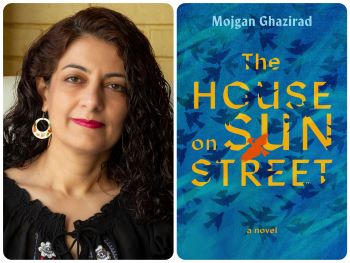The debut novelist talks Iran, the Islamic Revolution, and the power of stories to ignite our imagination.

Mojgan Ghazirad, praised as “a writer of incredible power and grace,” is also an assistant professor of pediatrics at George Washington University. Her debut novel, The House on Sun Street, chronicles the 1979 Iranian Revolution through the eyes of the charming, imaginative Moji. The book was inspired by her own experience growing up in Tehran. Ghazirad has also published three collections of short stories in Farsi, and her essays have appeared in numerous literary reviews.
Congratulations on your beautiful book! I was drawn to your novel by themes and approaches we share — namely, a young narrator wrestling with a strict, punitive religion as she wants to embrace the world. Seven-year-old Moji and her family leave Iran for Alabama to join her father, who is in graduate school in 1979, just before the shah is overthrown by Ayatollah Khomeini and Americans are taken hostage. Because of her mother’s homesickness, the family returns to Iran, which has dramatically changed in their time away. Talk about choosing a child as your novel’s narrator.
In the eyes of a child who is growing in the plush garden of her grandparents and is nurtured by her family’s love, witnessing the violent events in her country is horrifying. She observes the chaos that is brought to the streets and the crimes that take place in public places in Iran. Attending grade school in Alabama during the Iranian Hostage Crisis, she encounters meanness and racism as her classmates associate her with the abductors, with whom she shares only a nationality. Narrating these seismic events through the experiences of a child shifts the story from merely telling the historical events into an engaging coming-of-age story of a young girl trying to make sense of the changes in herself and the world she lives in.
The grandfather reads to Moji and her sister from One Thousand and One Nights, which Moji says, “planted the seeds of storytelling in my mind.” That book links her to her grandfather’s love, Scheherazade’s power, and pure imagination. Tell us some ways that book affected you.
There was mystery and an element of surprise in each story of One Thousand and One Nights. As my grandfather read those stories to me, I felt I had entered a magical world in which unexpected things could happen at any moment, and the thrill of exploring the unknown world kept me invested in the book. Later, as I reread the book as a teenage girl, they warded off the rough and violent world that surrounded me [during] those years.
You illustrate Iran’s fundamentalist shift through clothing, décor, music, and general mood. I was particularly struck by Moji’s aunt Saba’s transformation from a vibrant teen — enjoying her records, movie-idol posters, and jangly earrings — to a pious follower of Khomeini, cloaked in a black chador.
The Islamic Revolution in Iran was a cultural revolution at its core, and the rhetoric of the clerics who led the revolution was “to establish the rules of a pure Islam in the country.” In the opinion of Islamic clerics, singing, playing, or listening to music or having a vivid and colorful life is considered sinful, and as a result, harmful to a pious Muslim. As they took power in Iran, they banned everything that could bring joy and color to life. The idea was that a devout Muslim who refrains from a lavish life in this world would receive heavenly rewards in the afterlife, and this ideology appealed to youth in Iran since it was juxtaposed [with] the lavish and extravagant life the shah and his family had at that time. People, especially youth, were outraged by the social inequalities they had witnessed in the shah’s Iran.
Moji’s love for her librarian/teacher, a smart and progressive woman, is thrilling and forbidden. Talk about discovering and writing that part of her teenage experience.
As soon as Moji is accepted in her all-girl, gifted high school, she goes to the library, which is enormous and heavenly compared with the one in her elementary school. Shirin, the smart and young librarian, encourages her to explore the many volumes, and she hints at the existence of books that had been removed. Moji’s discovery of a hidden attic of banned books ignites a passion for the librarian, who opened this new world to her. For the young, enthusiastic Moji, who dares to step in mysterious, uncharted territories, the guide becomes the center of attention and love. She falls in love for the first time in her life, not aware of the dangers this would bring and the traumas it would cause.
Dissecting Moji’s emotions and capturing her inner thoughts during the critical time when her identity was forming was complicated and challenging. The more I developed her character on the page, the more distant she became from me. At some point in my writing about her struggles with love, she became the hero of the fictional work I had created. That is why The House on Sun Street is a work of fiction about a young girl growing [up] in the era of the Islamic Revolution in Iran and not a memoir of my life.
[Photo by Mehdi Bemani.]
Mary Kay Zuravleff is the author of American Ending, which was featured on Oprah Daily’s Spring Reading List.

